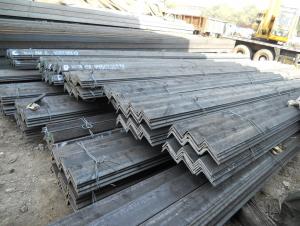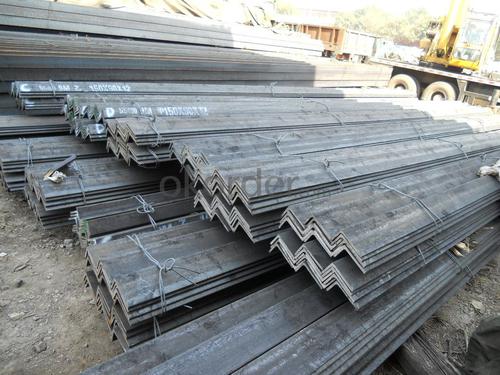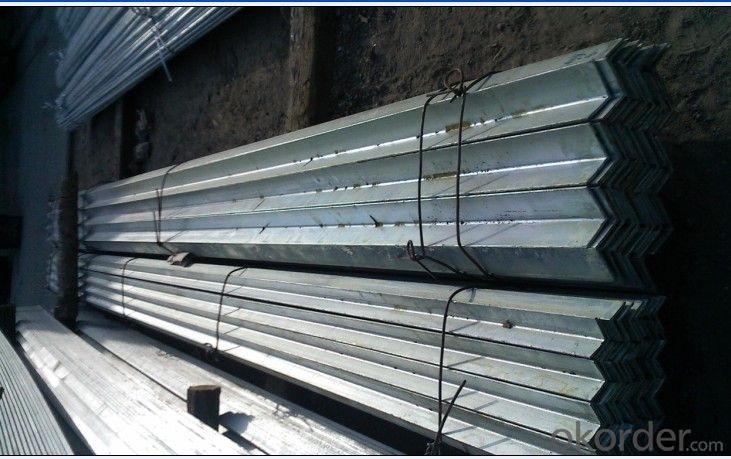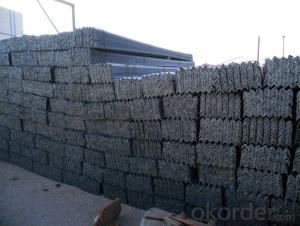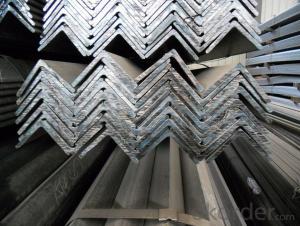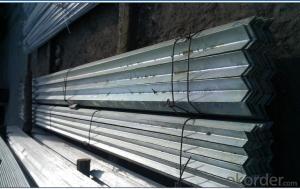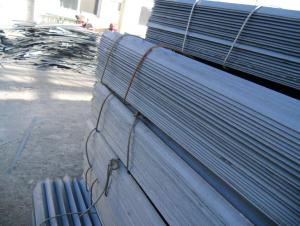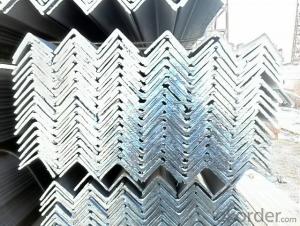Low Carbon Prime Steel Unequal Angle Bars
- Loading Port:
- Tianjin
- Payment Terms:
- TT or LC
- Min Order Qty:
- 100 m.t.
- Supply Capability:
- 20000 m.t./month
OKorder Service Pledge
OKorder Financial Service
You Might Also Like
OKorder is offering Low Carbon Prime Steel Unequal Angle Bars at great prices with worldwide shipping. Our supplier is a world-class manufacturer of steel, with our products utilized the world over. OKorder annually supplies products to African, South American and Asian markets. We provide quotations within 24 hours of receiving an inquiry and guarantee competitive prices.
Product Applications:
Low Carbon Prime Steel Unequal Angle Bars are ideal for structural applications and are widely used in the construction of buildings and bridges, and the manufacturing, petrochemical, and transportation industries
Product Advantages:
OKorder's Low Carbon Prime Steel Unequal Angle Bars are durable, strong, and wide variety of sizes.
Main Product Features:
· Premium quality
· Prompt delivery & seaworthy packing (30 days after receiving deposit)
· Can be recycled and reused
· Mill test certification
· Professional Service
· Competitive pricing
Product Specifications:
Manufacture: Hot rolled
Grade: Q195 – 235
Certificates: ISO, SGS, BV, CIQ
Length: 6m – 12m, as per customer request
Packaging: Export packing, nude packing, bundled
| UNEQUAL ANGLE STEEL | |||||
| size(mm) | a(mm) | a1(mm) | thickness(mm) | kg/m | length(m) |
| 75*50*5 | 75 | 50 | 5 | 4.808 | 6m,9m,12m |
| 75*50*6 | 75 | 50 | 6 | 5.699 | 6m,9m,12m |
| 75*50*8 | 75 | 50 | 8 | 7.431 | 6m,9m,12m |
| 100*75*7 | 100 | 75 | 7 | 9.34 | 6m,9m,12m |
| 100*75*8 | 100 | 75 | 8 | 10.6 | 6m,9m,12m |
| 100*75*9 | 100 | 75 | 9 | 11.8 | 6m,9m,12m |
| 100*75*10 | 100 | 75 | 10 | 13 | 6m,9m,12m |
| 100*75*12 | 100 | 75 | 12 | 15.4 | 6m,9m,12m |
| 125*75*7 | 125 | 75 | 7 | 10.7 | 6m,9m,12m |
| 125*75*8 | 125 | 75 | 8 | 12.2 | 6m,9m,12m |
| 125*75*9 | 125 | 75 | 9 | 13.6 | 6m,9m,12m |
| 125*75*10 | 125 | 75 | 10 | 15 | 6m,9m,12m |
| 125*75*12 | 125 | 75 | 12 | 17.8 | 6m,9m,12m |
| 150*90*8 | 150 | 90 | 8 | 14.7 | 6m,9m,12m |
| 150*90*9 | 150 | 90 | 9 | 16.4 | 6m,9m,12m |
| 150*90*10 | 150 | 90 | 10 | 18.2 | 6m,9m,12m |
| 150*90*12 | 150 | 90 | 12 | 21.6 | 6m,9m,12m |
| 200*100*10 | 200 | 100 | 10 | 23 | 6m,9m,12m |
| 200*100*12 | 200 | 100 | 12 | 27.62 | 6m,9m,12m |
| 200*100*15 | 200 | 100 | 15 | 34.04 | 6m,9m,12m |
FAQ:
Q1: Why buy Materials & Equipment from OKorder.com?
A1: All products offered byOKorder.com are carefully selected from China's most reliable manufacturing enterprises. Through its ISO certifications, OKorder.com adheres to the highest standards and a commitment to supply chain safety and customer satisfaction.
Q2: How do we guarantee the quality of our products?
A2: We have established an advanced quality management system which conducts strict quality tests at every step, from raw materials to the final product. At the same time, we provide extensive follow-up service assurances as required.
Q3: How soon can we receive the product after purchase?
A3: Within three days of placing an order, we will arrange production. The normal sizes with the normal grade can be produced within one month. The specific shipping date is dependent upon international and government factors, the delivery to international main port about 45-60days.
Images:

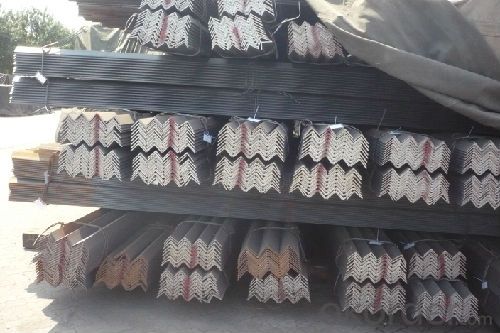
- Q: Can steel angles be customized or fabricated to specific requirements?
- Steel angles have the ability to be customized or fabricated according to specific requirements. With their versatility, steel angles can easily be modified to meet a variety of specifications and applications. Various fabrication processes, such as cutting, drilling, welding, and bending, can be employed to tailor steel angles to the desired shape, size, and dimensions. This enables the creation of steel angles with specific lengths, thicknesses, and angles, satisfying the unique demands of construction or engineering projects. Customized steel angles find utility in numerous applications, including structural framing, supports, brackets, reinforcements, and architectural designs. In summary, the flexibility of steel angles in customization and fabrication makes them highly suitable for meeting a wide range of construction and industrial needs.
- Q: Can steel angles be used for structural support?
- Indeed, steel angles can serve as a means of providing structural support. Construction and engineering endeavors frequently employ steel angles in order to furnish structures with the necessary support and stability. Their application is particularly common in the construction of buildings, bridges, and various other forms of infrastructure. Steel angles possess strength and durability, rendering them suitable for bearing substantial loads and withstanding the forces of compression and tension. Furthermore, their L-shaped design facilitates effortless installation and connection to additional structural elements. By employing steel angles as beams, columns, braces, and other structural components, it is possible to endow a structure with both stability and strength.
- Q: What is the fire resistance rating of steel angles?
- The fire resistance of steel angles relies on several factors, including the angle's size and thickness, the type of steel employed, and the specific fire protection measures implemented. Steel possesses inherent fire resistance due to its high melting point and low thermal conductivity. Nevertheless, the fire resistance can be improved by applying fireproofing materials, such as intumescent coatings or fire-resistant boards, to the steel angles. By providing insulation and slowing down heat transfer to the steel, these fire protection measures can significantly augment the fire resistance of steel angles. The specific fire resistance rating may differ depending on the thickness and type of fireproofing materials employed. For instance, a steel angle coated with a particular fireproofing substance may have a fire resistance rating of 60 minutes, signifying its ability to withstand fire exposure for up to 60 minutes without compromising its structural integrity. To determine the specific fire resistance requirements for steel angles in a specific application, it is crucial to refer to local building codes, regulations, and fire safety standards. These standards can offer guidance on the necessary fire protection measures and the minimum fire resistance ratings that must be met in different construction scenarios.
- Q: What are the common design codes or standards for steel angles?
- There are several common design codes and standards that govern the use of steel angles in structural design. These codes and standards ensure that the angles are designed and manufactured to meet certain safety and performance criteria. One of the most widely used design codes for steel angles is the American Institute of Steel Construction (AISC) Manual of Steel Construction. The AISC provides comprehensive guidelines and specifications for the design, fabrication, and erection of steel structures, including angles. This manual includes detailed information on the design strength, allowable stress levels, and geometric properties of angles. In addition to the AISC Manual, other design codes and standards may also be applicable depending on the specific project and location. These include international standards such as the Eurocode, British Standards (BS), and Australian Standards (AS). Each of these standards may have slightly different requirements for the design and use of steel angles, so it is important to consult the appropriate standard for the specific project. Furthermore, the American Society for Testing and Materials (ASTM) has established standards for the physical and mechanical properties of steel angles. These standards ensure that the angles meet certain quality and performance requirements. The most commonly used ASTM standard for steel angles is ASTM A36, which specifies the general requirements for carbon structural steel. Overall, the common design codes and standards for steel angles provide guidance on factors such as load capacity, strength, and safety considerations. Adhering to these codes and standards ensures that steel angles are designed and used in a manner that promotes structural integrity and reliability.
- Q: Can steel angles be used in the construction of oil refineries?
- Yes, steel angles can be used in the construction of oil refineries. Steel angles are commonly used in construction projects due to their high strength and durability. They provide structural support and are suitable for various applications, including the construction of oil refineries. The angles can be used to create frameworks, supports, and bracing for different components and equipment within the refinery. They offer stability and resistance to heavy loads and harsh environments, which is essential in the oil refining industry. Additionally, steel angles can be easily welded, bolted, or connected to other steel members, making them a versatile choice for refinery construction.
- Q: What are the different types of steel angles used in bridges?
- There are several different types of steel angles that are commonly used in bridges for various purposes. These include: 1. Equal Leg Angles: These angles have equal legs and are commonly used for structural support in bridge construction. They provide stability and strength to the bridge structure. 2. Unequal Leg Angles: As the name suggests, these angles have unequal legs and are used in situations where additional strength or specific load-bearing requirements are necessary. They are often used in combination with equal leg angles to provide support and distribute weight evenly. 3. L-Shaped Angles: L-shaped angles are used for various purposes in bridge construction, such as connecting beams and columns or providing additional support at connection points. They are often used in combination with other types of angles to create a sturdy and well-supported bridge structure. 4. Tapered Angles: Tapered angles are used in bridges where a change in width or height is required. These angles are often used in bridge piers or abutments to provide a smooth transition between different sections of the bridge. 5. Bent Angles: Bent angles are used in bridges where a specific angle is required to accommodate the design or alignment of the bridge. These angles are often custom-made to fit the specific needs of the bridge construction project. 6. Hollow Structural Section (HSS) Angles: HSS angles are hollow steel sections that are used in bridge construction to provide additional strength and reduce the weight of the structure. These angles are commonly used in situations where weight reduction is a priority, such as in long-span bridges or bridges with high load-bearing requirements. Each of these steel angles serves a specific purpose in bridge construction, and their selection depends on factors such as the design requirements, load-bearing capacity, and structural stability needed for the bridge.
- Q: Can steel angles be used for outdoor applications?
- Indeed, outdoor applications can make use of steel angles. Fashioned from a robust and enduring material, steel angles prove themselves apt for a multitude of outdoor endeavors. Frequently employed in construction, infrastructure, and engineering ventures necessitating structural support or reinforcement, steel angles endure inclement weather conditions, including rain, snow, and direct sunlight, without succumbing to decay or weakening. Moreover, steel angles possess the potential to be coated or treated, amplifying their ability to resist corrosion and further augmenting their appropriateness for outdoor applications. On the whole, steel angles present themselves as a dependable and adaptable option for outdoor projects requiring durability, strength, and long-term reliability.
- Q: What are the different methods of connecting steel angles to other structural elements?
- There are several methods for connecting steel angles to other structural elements. Some common methods include bolting, welding, and using angle connectors or brackets. Bolting involves using bolts and nuts to secure the steel angles to the other elements. Welding involves fusing the steel angles with the other elements using heat and filler material. Angle connectors or brackets are specifically designed connectors that provide a secure and rigid connection between the steel angles and other structural elements. These methods vary in terms of their complexity, cost, and structural stability, and the choice of method depends on factors such as the load requirements and design specifications of the structure.
- Q: What are the different methods of surface preparation for steel angles?
- There are several methods of surface preparation for steel angles in order to ensure proper adhesion of coatings, improve corrosion resistance, and enhance the overall durability of the material. Some of the common methods include: 1. Mechanical Cleaning: This involves using mechanical tools such as wire brushes, sandpaper, or abrasive discs to physically remove dirt, rust, mill scale, and other contaminants from the surface of the steel angles. This method is relatively simple and cost-effective but may not be suitable for heavy corrosion or stubborn deposits. 2. Chemical Cleaning: Chemical cleaning involves the use of acid-based solutions or pickling pastes to dissolve rust, scale, and other contaminants. The solution is applied to the surface and left for a specific period before being rinsed off. This method is highly effective in removing stubborn deposits but requires careful handling and proper disposal of the chemicals. 3. Power Tool Cleaning: Power tool cleaning utilizes power tools like grinders, sanders, or needle guns with abrasive attachments to remove rust, scale, and other contaminants. This method is faster and more efficient than manual mechanical cleaning, making it suitable for large-scale surface preparation. 4. Blast Cleaning: Blast cleaning, also known as abrasive blasting, involves propelling abrasive materials (such as sand, steel grit, or glass beads) at high velocity onto the steel surface using compressed air or centrifugal force. This method effectively removes rust, scale, and other contaminants, providing a clean and profiled surface. It is widely used in industrial applications but requires proper safety measures to protect workers from exposure to abrasive materials. 5. Flame Cleaning: Flame cleaning is a method where a high-temperature flame is directed onto the steel surface to remove contaminants. The intense heat burns off organic materials and evaporates moisture, leaving a clean surface. This method is particularly useful for removing oil, grease, and paint residues. 6. Conversion Coating: Conversion coating involves applying a chemical solution onto the steel surface, which reacts with the metal to form a thin protective layer. This layer enhances the adhesion of subsequent coatings and provides additional corrosion resistance. Common conversion coatings include phosphating, chromating, and passivation. It is important to note that the selection of the most appropriate surface preparation method depends on factors such as the extent of corrosion, the desired coating system, and the environmental conditions the steel angles will be exposed to. Consulting with experts or referring to industry standards can help determine the most suitable method for a specific application.
- Q: What do you mean by "corner steel plate pull knot"?
- The specifications are expressed in millimeters of edge width * edge width * edge thickness. Such as "30 x 30 x 3", that is 30 mm width equal angle, edge thickness of 3 mm. Also available models that model is the number of centimeters wide, such as 3#. The model does not mean the size of the different edges and sizes of the same model. Therefore, the width, the edge and the thickness of the angle iron should be filled out in the contract and other documents, so as not to be indicated by the model alone. Standard Specification for hot-rolled equal angle iron is 2#-20#.
Send your message to us
Low Carbon Prime Steel Unequal Angle Bars
- Loading Port:
- Tianjin
- Payment Terms:
- TT or LC
- Min Order Qty:
- 100 m.t.
- Supply Capability:
- 20000 m.t./month
OKorder Service Pledge
OKorder Financial Service
Similar products
Hot products
Hot Searches
Related keywords
